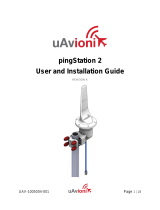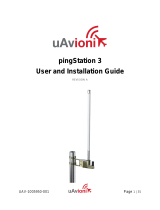Page is loading ...

Communication Port EAP-CP8

3
1. Product Introduction
The equipment supports the gigabit Ethernet to ensure wireless high-speed transmission; it is
deployed simply with PoE remote power supply. The device housing fully supports enclosed
waterproof, moisture-proof, dust-proof, fireproof, sunscreen, etc. with the highest protection level
of IP 68.
2. Product Main Characteristics
Excellent outdoor adaptability: The product supports fully enclosed waterproof,
moisture-proof, dust-proof, fire prevention, sun protection, etc. with the ultra-high protection
level IP68.
High efficient transfer: Device supports the gigabit Ethernet and the WiFi channels support to
be changed easily. The data transmission rate is up to 3Gbps to make sure the high-speed
wireless transmission.
Directional antenna: The transmission power of the built-in directional antenna can be
adjusted easily. The antenna covers a certain aera to meet the wireless coverage requirement
of UAV.
3. Product Description
The Communication Port, as an important accessory of the CROSS STARS III UAV,
ensures the safety of the whole communication network of the UAV. The overall weight is 2.25kg,
the size is 242 * 242 * 68mm, and the network port is compatible with POW power supply. The
device contains the following components, as shown in the figure as below:

4
1. Transmission Unit: It can be adjusted the power and frequency by the software
configuration tool to meet the compliance requirements of each country. The
directional antenna transmits the signals to the UAV long distance.
2. Ethernet port: The speed of the port supports the gigabit and 100M ethernet to meet
the different Scenario. The port supports the POE power supply to reduce deployment
complexity.
3. Housing: With the IP68 protection level, it can work in extreme harsh environments.
4. Product Parameter Description
The Communication Port (EAP-CP8) is an important supporting ground equipment for the
CROSS STARS III UAV. It is a bridge of the WiFi network to establish the WiFi communication
between the aircraft and the ground station. The detailed parameters as below:
Communication Port EAP-CP8 Product Parameter Table
Num Item Parameter
1 Overall weight 2.25kg
2 Size 242*242*68mm
3 Power supply 48VDC/0.53A
4 Power ≤25W
5 Transmitting power ≤20dBm
6 Antenna The directional antenna
7 IP Grade IP68
8
Wireless frequency
WIFI:
5.18-5.24GHz(MIC)
5.18-5.24GHz,5.745-5.825GHz(CE/UKCA/FCC)
2.412-2.462GHz(FCC)
2.412-2.472GHz(CE/UKCA/MIC)
9
Operating temperature -40℃~70℃
Warning: Changes or modifications to this unit not expressly approved by the party responsible for
compliance could void the user’s authority to operate the equipment.
NOTE: This device complies with part 15 of the FCC Rules. Operation is subject to the following
two conditions: (1) This device may not cause harmful interference, and (2) this device must
accept any interference received, including interference that may cause undesired operation.
FCC Statement: This equipment has been tested and found to comply with the limits for a Class B
digital device, pursuant to part 15 of the FCC Rules. These limits are designed to provide
reasonable protection against harmful interference in a residential installation. This equipment
generates, uses and can radiate radio frequency energy and, if not installed and used in
accordance with the instructions, may cause harmful interference to radio communications.
However, there is no guarantee that interference will not occur in a particular installation. If this
equipment does cause harmful interference to radio or television reception, which can be
determined by turning the equipment off and on, the user is encouraged to try to correct the
interference by one or more of the following measures:
—Reorient or relocate the receiving antenna.
—Increase the separation between the equipment and receiver.
—Connect the equipment into an outlet on a circuit different from that to which the receiver is
connected.
—Consult the dealer or an experienced radio/TV technician for help.
The equipment complies with FCC Radiation exposure limit set forth for uncontrolled environment.
This equipment should be installed and operated with minimum distance 20cm between the
radiator and your body.
/





